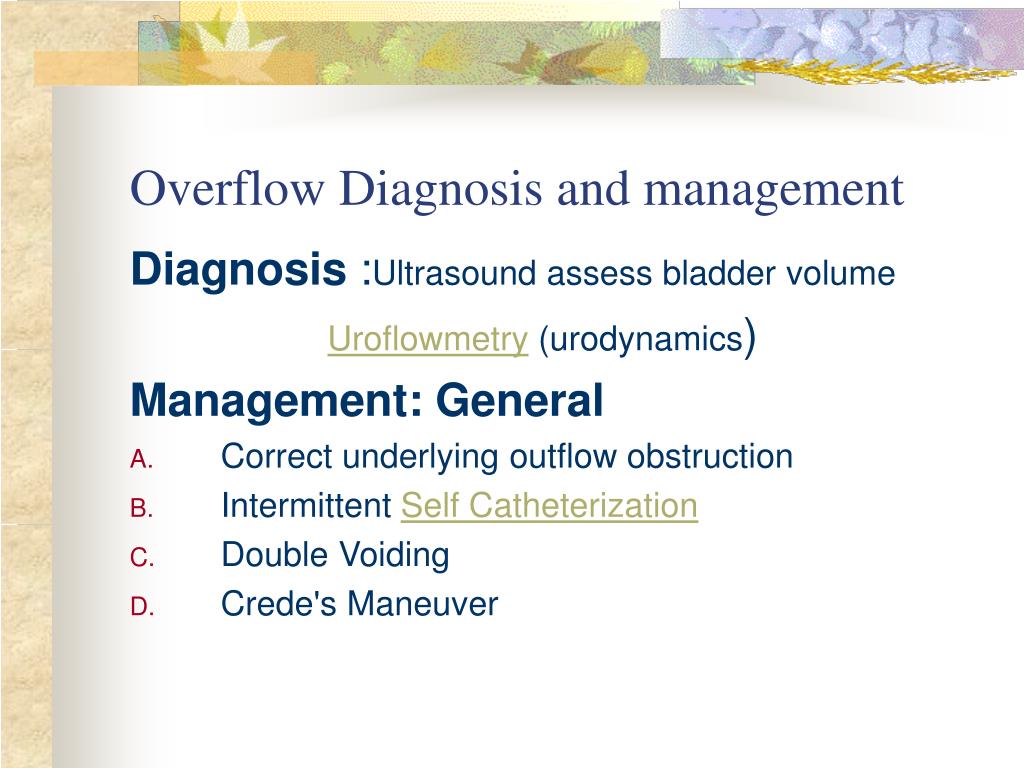

Periurethral injections of bulking agentsĬombination of above treatments with focus on dominant symptomsĪlpha-adrenergic antagonists or blockers (e.g., tamsulosin ) Retropubic urethropexy or colposuspension (i.e., Burch and Marshal-Marchetti-Krantz procedures) Suburethral sling with tension-free vaginal tape Mechanical devices (e.g., pessary, urethral plugs)Īlpha-adrenergic agonists (e.g., pseudoephedrine, phenylephrine) *
OVERFLOW INCONTINENCE SDN MANUAL
Pelvic floor muscle exercises (alone or with manual or biofeedback) Neuromodulation (implanted sacral nerve stimulator) More often occurs in patients with arthritis, gait disturbance, or dementiaĮlectrical stimulation of the posterior tibial nerveīeta-adrenergic agonists (mirabegron )

Loss of urine associated with inability to toilet because of impaired cognitive, psychological, or physical function More often occurs because of neurologic disordersĬognitive, mobility, or psychological impairment Impaired detrusor contractility from neurologic disorders, including diabetic neuropathyĭribbling and/or continuous leakage associated with incomplete bladder emptyingīladder outlet obstruction is uncommon in women Loss of urine with physical exertion or increases in intra-abdominal pressure (e.g., sneezing, coughing, laughing) Loss of urine accompanied or preceded by strong desire to void may be accompanied by frequency and nocturia

Surgical interventions, such as sling and urethropexy procedures, should be reserved for stress incontinence that has not responded to other treatments. Minimally invasive procedures, including radiofrequency denaturation of the urethra and injection of periurethral bulking agents, can be used if stress incontinence does not respond to less invasive treatments. Food and Drug Administration for this condition. Limited or conflicting evidence exists for the use of medications for stress incontinence no medications are approved by the U.S. Alternatives for treating stress incontinence include vaginal inserts, such as pessaries, and urethral plugs. Noninvasive electrical and magnetic stimulation devices are also available. Pelvic floor muscle exercises are considered first-line treatment for stress incontinence. Sacral nerve stimulators, which are surgically implanted, have also been shown to improve symptoms of urge incontinence. Other medication options for urge incontinence include mirabegron and onabotulinumtoxinA. Pharmacologic therapy with anticholinergic medications is another option for treating urge incontinence if behavioral therapy is unsuccessful however, because of adverse effects, these agents are not recommended in older adults. Neuromodulation devices, such as posterior tibial nerve stimulators, are an option for urge incontinence that does not respond to behavioral therapy. Bladder retraining and pelvic floor muscle exercises are first-line treatments for persons without cognitive impairment who present with urge incontinence. A stepped-care approach that advances from least invasive (behavioral modification) to more invasive (surgery) interventions is recommended. All of these depends on the condition and severity of the obstruction.Most cases of urinary incontinence in women fall under one of three major subtypes: urge, stress, or mixed. Additionally, you may feel nauseous and a fever might appear. There may be an increased urge to go to the toilet to urinate and incontinence. Alternative signs or symptoms involves pain while urinating.

The main symptom is pain, either on the sides and back (commonly known as flank pain), groin and abdomen. Hydrophrenosis might not show any signs or symptoms. This might lead to an overflow, or it experiences a reflux which can cause swelling in the renal pelvis. when there is too much urine, it forms a build up when there is an obstruction. Eventually, the bladder gets filled with urine which exits from the body through the urethra. The renal pelvis collects urine and it goes down the ureter tube and enters the bladder. There is urine when the kidneys are functioning normally to filter blood and remove excess waste and fluid. The primary purpose of the urinary tract is to excrete waste and excess fluid out from the body. The urinary tract is made up of four separate parts, the kidneys, the ureters, the bladder, and urethra. This can affect either one or in both of the kidneys. The kidney is unable to excrete urine to the bladder because there is an blockage. Hydronephrosis develops when there swelling in the kidney due to an accumulation of urine.


 0 kommentar(er)
0 kommentar(er)
